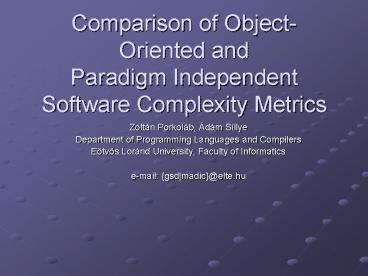Comparison of ObjectOriented and Paradigm Independent Software Complexity Metrics - PowerPoint PPT Presentation
1 / 22
Title:
Comparison of ObjectOriented and Paradigm Independent Software Complexity Metrics
Description:
... of the software. Specification. Design. Implementation. Testing & Bug-fixing ... Software metrics: Measuring the development process (process metrics) ... – PowerPoint PPT presentation
Number of Views:128
Avg rating:3.0/5.0
Title: Comparison of ObjectOriented and Paradigm Independent Software Complexity Metrics
1
Comparison of Object-Oriented andParadigm
IndependentSoftware Complexity Metrics
- Zoltán Porkoláb, Ádám Sillye
- Department of Programming Languages and Compilers
- Eötvös Loránd University, Faculty of Informatics
- e-mail gsdmadic_at_elte.hu
2
The structure of the presentation
- The role of software metrics
- Metrics an overview
- Object-oriented software metrics
- Multiparadigm programming
- The AV-graph
- Empirical results
3
Role of software metrics
- Cost of the software
- Specification
- Design
- Implementation
- Testing Bug-fixing
- Maintenance
- More than 70 of cost is for testing and
maintenance (Zuse 1998) - Software quality
4
Software metrics
- Software metrics
- Measuring the development process (process
metrics) - Measuring the product (product metrics)
- Product metrics
- External metrics
- Reliability metrics
- Functional metrics
- Efficiency metrics
- Internal product metrics
- Size
- Complexity
- Style
5
Product metrics
- Size metrics
- LOC, eLOC
- Ignore the semantic
- Structural metrics
- McCabe 1976
- Motivation predict testing efforts
- For structured programs V(G) p 1
- Howatt and Baker 1989
- Motivation involve nesting level
- SN(G) NND(G)
6
Object-oriented metrics in theory
- Chidamber-Kemerer (1994) OO metrics suite
- WMC (Weighted Methods per Class)
- DIT (Depth of Inheritance Tree, DIT)
- NOC (Number of Child Classes)
- CBO (Coupling Between Object Classes) fan-in and
fan out - RFC (Response for Class)
- LCOM (Lack of Cohesion in Methods)
- Chidamber - Kemerer
- Henderson - Sellers
7
Object-Oriented metrics in practice
- Eclipse (www.eclipse.org)
- McCabe cyclomatic complexity
- Efferent coupling (? fan out!)
- Lack of Cohesion
- LOC (Lines of Code)
- Number of Fields in Classes
- Nesting Depth
- Number of Method Parameters
- Number of Statements
- Weighted Methods per Class
8
Software paradigm
- Evolution of Software paradigm
- Structured programming
- Object-oriented programming
- Classes, inheritance, virtual function
- Generative programming
- Aspect-Oriented (Kitzales 1994)
- Intentional (Simonyi 1995)
- Template metaprogramming (Veldhuizen 1994)
- Multiparadigm programming (Coplien 1998)
- Simultaneous usage of paradigms
9
Paradigm-independent Software Metrics
- Applicable for programs written in different
paradigms or in mixed-paradigm environment - Based on general programming language features
which are paradigm- and language-independent.The
paradigm-dependent attributes are derived
fromthese features.
10
Components
- Control Structure of Program
- Most of the programs share the same control
statements - Complexity of Data Types
- Reflects the complexity of data types used (like
classes) - Complexity of Data Access
- Connection between control structure and data
- Direction of data flow
- Nesting depth
11
AV-graph
12
AV-graph metrics
- N number of nodes
- nd(n) Pred(n) nesting depth of node n
- ND(G) S nd(n) for all nodes
- C(G) N ND(G)
- C(O) N S ND(G)
- A S (ND(G) L)
13
Complexity of class
- Control structures
- Complexity of method control structures
- Complexity of data types
- Local variables in methods
- Attributes (could be complex types)
- Coupling between classes
- Inheritance
- Complexity of data handling
- Connection between control structure and data
14
Complexity of Class
class date public void set_next_month()
if ( month 12 ) month 1 year
year 1 else month month
1 void set_next_day() if
( month 1 month 3 ... month 12
) if ( day 31 )
set_next_month() else
day day 1 else if ( day
30 ) set_next_month() else
day day 1 private int year,
month, day
15
Our Measuring tool
- Supported languages
- Java 1.3
- Java 1.4 (assert)
- Future directions C and C
- Implementation
- ANTLR
- User interface standalone application and
Eclipse Plug-in - Ouput
- CSV
- XML
16
Applied Metrics
- Object-Oriented Metrics
- Inner Class Depth
- Inheritance level
- Number of Children
- Number of Methods
- Number of Fields
- LCOM
- Henderson-Sellers LCOM
- Fan-out
17
Applied Metrics
- Size Metrics
- eLOC
- Number of Statements
- McCabe
- Howatt-Baker
- AV-graph
18
Test Data
- Java Standard Library 1.4.2
- 367.000 eLOC
- jBOSS 3.2.3
- 300.000 eLOC
- Omg.org.CORBA
- 5.000 eLOC
- The measure tool (with mostly generated parser)
- 7.000 eLOC
- Eclipse 3.0M6
- 900.000 eLOC
- 17.000 class more than 1.5 million lines
19
Calibrating our tool
- Goal
- Achieve similar results with other measuring
programs. (Otherwise we are unable to compare the
results.) - Difficulties
- Metrics are not defined precisely enough from the
view of implementation. - Available tools
- working on different abstract program tree.
- use simplified metrics definitions.
- and have several bugs.
20
Example
- Lack of Cohesion in Methods
- P method pairs that access different fields
- Q method pairs that access at least one common
field - LCOM P-Q if P-Q0, otherwise 0.
- References to this and super have to be counted
or not in the sense of cohesion? - No, but some tools count them.
21
Results
- No statistical correlation between the OO and
multi paradigm metrics - OO metrics only measure the big picture
- MPM consider more properties higher density
- The structural complexity of methods are
extremely increase the overall complexity.
22
Conclusion
- Implementations are not reliable yet
- No precise definition for metrics
- Different input data languages
- Tools
- Various interpretation of definitions.
- Various bugs.
- Results of different tools cannot be compared.
- Future examination...































